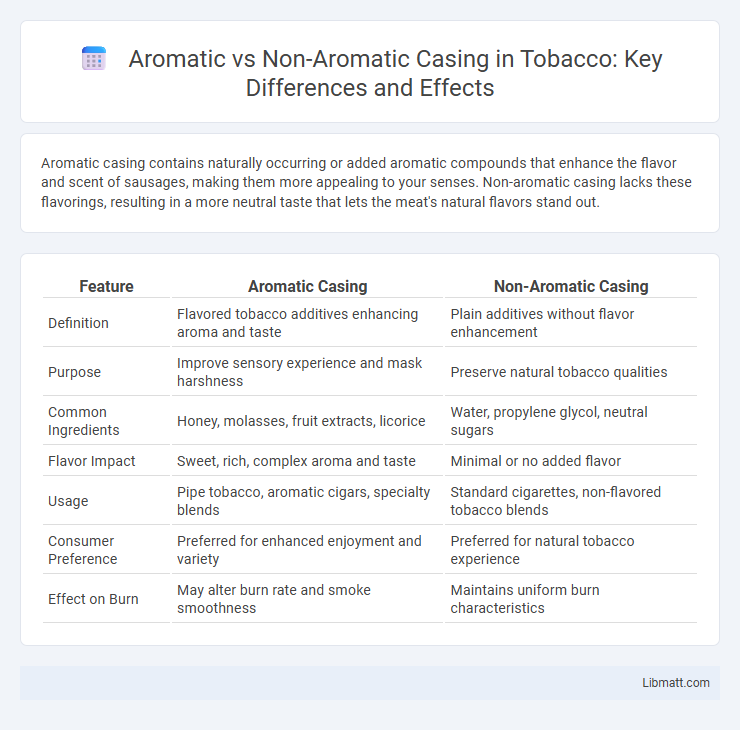Aromatic casing contains naturally occurring or added aromatic compounds that enhance the flavor and scent of sausages, making them more appealing to your senses. Non-aromatic casing lacks these flavorings, resulting in a more neutral taste that lets the meat's natural flavors stand out.
Table of Comparison
| Feature | Aromatic Casing | Non-Aromatic Casing |
|---|---|---|
| Definition | Flavored tobacco additives enhancing aroma and taste | Plain additives without flavor enhancement |
| Purpose | Improve sensory experience and mask harshness | Preserve natural tobacco qualities |
| Common Ingredients | Honey, molasses, fruit extracts, licorice | Water, propylene glycol, neutral sugars |
| Flavor Impact | Sweet, rich, complex aroma and taste | Minimal or no added flavor |
| Usage | Pipe tobacco, aromatic cigars, specialty blends | Standard cigarettes, non-flavored tobacco blends |
| Consumer Preference | Preferred for enhanced enjoyment and variety | Preferred for natural tobacco experience |
| Effect on Burn | May alter burn rate and smoke smoothness | Maintains uniform burn characteristics |
Understanding Aromatic and Non-Aromatic Casings
Aromatic casings are typically infused with natural or synthetic flavor compounds that enhance the sensory profile of sausages, providing distinctive herbal or smoky notes favored in gourmet products. Non-aromatic casings, often made from collagen or cellulose, are neutral in flavor and primarily serve as protective barriers without influencing the taste of the meat inside. Understanding the choice between aromatic and non-aromatic casings is crucial for manufacturers aiming to achieve specific flavor profiles and meet consumer preferences in sausage production.
Key Differences Between Aromatic and Non-Aromatic Casings
Aromatic casings contain natural or artificial flavor compounds that enhance the taste and aroma of the product, making them ideal for specialty sausages and gourmet meats. Non-aromatic casings lack these added flavor characteristics, resulting in a more neutral taste that highlights the meat's natural flavors. Your choice between aromatic and non-aromatic casings impacts the final product's sensory profile and suitability for different culinary applications.
Composition and Materials Used
Aromatic casing typically consists of natural or synthetic casings infused with natural or artificial flavor compounds such as herbs, spices, and essential oils to enhance the flavor profile of sausages and cured meats. Non-aromatic casing is made from materials like collagen, cellulose, or natural intestines without added flavor agents, providing a neutral barrier that preserves the meat's original taste. Your choice between aromatic and non-aromatic casings depends on whether you want the casing to impart additional flavor or simply serve as a protective layer.
Impact on Flavor and Aroma Profiles
Aromatic casing significantly enhances the flavor and aroma profiles of tobacco products by infusing rich, complex scents such as vanilla, cherry, or spice, which create a more enjoyable and fragrant smoking experience. Non-aromatic casing maintains the tobacco's natural, robust flavor without additional scenting agents, appealing to smokers who prefer a pure, unaltered taste. The choice between aromatic and non-aromatic casing directly influences the sensory characteristics, with aromatic casings adding sweetness and smoothness, while non-aromatic options emphasize the tobacco's inherent earthy and bold notes.
Applications in Food and Tobacco Industries
Aromatic casing enhances flavor profiles and moisture retention in meat products, making it ideal for sausages and smoked meats in the food industry. Non-aromatic casing, offering a neutral taste, is preferred in tobacco products to maintain the pure tobacco flavor without altering aroma. Both casings play crucial roles in their respective industries, with aromatic casing elevating culinary experience and non-aromatic casing preserving tobacco quality.
Benefits of Aromatic Casings
Aromatic casings enhance the flavor profile of sausages by infusing subtle herbal and spice notes that elevate the overall taste experience. These casings often improve the aroma, making your meat products more appealing and distinctive in competitive markets. Using aromatic casings can also contribute to better moisture retention, resulting in juicier, more flavorful sausages that satisfy discerning consumers.
Advantages of Non-Aromatic Casings
Non-aromatic casings offer superior durability and resistance to heat, making them ideal for high-temperature cooking processes such as grilling and smoking. These casings are typically made from collagen or cellulose, providing a consistent texture and ease of peeling, which enhances product presentation and consumer appeal. Their neutral taste ensures that the flavor of the sausage remains unaltered, allowing for more versatile seasoning options and broader culinary applications.
Consumer Preferences and Trends
Consumer preferences for aromatic casing show a strong inclination towards enhanced flavor profiles and sensory experience, often associated with premium product quality. Non-aromatic casing appeals to those seeking a milder, more neutral taste, fitting health-conscious or traditional preferences. Your choice between aromatic and non-aromatic casings directly influences product appeal in diverse markets driven by evolving trends and flavor expectations.
Health and Safety Considerations
Aromatic casing contains synthetic compounds that may release volatile organic compounds (VOCs), posing potential respiratory and skin irritation risks during processing and consumption. Non-aromatic casing, often made from natural materials, generally presents fewer chemical hazards but requires careful handling to avoid microbial contamination. Your choice between aromatic and non-aromatic casing should consider these health and safety factors to ensure safer food production and consumer well-being.
Choosing the Right Casing for Your Needs
Aromatic casings, made from collagen treated with aromatic compounds, offer enhanced flavor and a distinct smoky aroma, ideal for specialty sausages and artisanal products. Non-aromatic casings, typically natural or synthetic without aromatic additives, provide a neutral taste and greater versatility for a wide range of meat products. Choosing the right casing depends on your desired flavor profile, product type, and processing requirements to achieve the best culinary results.
aromatic casing vs non-aromatic casing Infographic

 libmatt.com
libmatt.com